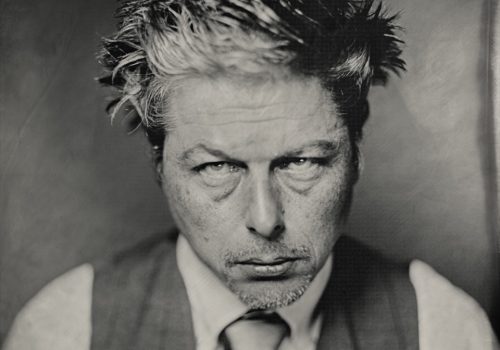The hegemony of digital images has backfired, generating a renewed interest in analog photography, and in historical photographic processes in particular. Anxious to distance themselves from the daily flood of pixels, photographers are returning to the daguerreotype, salt or wax paper, gum bichromate, and tintype. These techniques are meticulous, time-consuming, and demanding. They remind us that photography used to be a matter of chemistry as much as optics.
The Swiss Camera Museum in Vevey has devoted numerous exhibitions to nineteenth-century processes, which often were abandoned as soon as they appeared. Yet one technique was absent from the list: the wet collodion process, invented by Frederick Scott Archer, in the wake of Gustave Le Gray’s pioneering work.
Sébastien Kohler’s portraits, sort of 2017 hipster style, have now filled that gap. A self-taught photographer, the Lausanne native became fascinated a few years ago with the complex technique of wet plate collodion. A video screened in the exhibition shows him at work in his studio, preparing the liquid and skillfully applying it to the glass plate, which he bathes in silver nitrate; then loading his camera before the liquid dries, and asking his model to remain motionless for several seconds; then developing the exposed plate and rinsing it in fresh water.
The film tells us that the glass negative turns into a positive in the fixer, which would be a big first in the history of photography. In reality, the photographer presents his plates in the form of an ambrotype, a technique patented in 1854 by James Ambrose Cutting. The glass negative is placed in front of a dark background and lit from the front. As the light illuminates the metallic silver, the image appears as a positive.
Sébastien Kohler photographs his subjects frontally, in close-up. The depth of field is shallow, the subject’s eyes are in focus, and occasional blemishes intimate the antiquity of the technique. The shades of grey are sumptuous, as is the materiality of skin, hair, and fabrics. These contemporary portraits emanate an intense beauty, as Kohler poses his friends and acquaintances: artists, actors, creators, and other members of the cultural community of French-speaking Switzerland. There are no smiles, the sitters are tense, their attitudes frozen—a result of prolonged posing sessions endured with the aid of a headrest.
The temporal effect is twofold, referring to the past as well as to the present. The subjects could not be more contemporary, looking sharp, stylish, and elegant. But the photographic process tips the scene into the nineteenth century, bringing to the surface memories of similar portraits, more than a hundred years old. The impression is so intense that black skin or Asian features evoke, against one’s better judgment, the era of slavery or the colonial period. When you stir memories, you always risk arousing ghosts of the past.
A reverse trend, nineteenth-century-style photography, with its preference for stasis over the mobility of the digital image, exemplifies a current penchant for nostalgia. This is how things are: in its most aestheticizing regions, photography in 2017 loves to tell its own story. It showcases its origins in order to acquire a new legitimacy. We are thus dealing with a new mannerism, bella maniera, which builds on borrowings and citations. Like all types of mannerism, vintage photography marks the end of an era: and more specifically, the end of the era of the unique, tangible, silver-based image.
Luc Debraine
Luc Debraine is a culture and society journalist. He lives and works in Lausanne, Switzerland.
Sébastien Kohler, Ambrotypes
September 13, 2017 to March 14, 2017
Camera Museum
Grande Place 99
1800 Vevey
Suisse
















